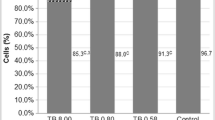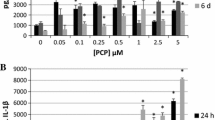Abstract
2,2′-Dichlorodiethyl sulfide (sulfur mustard, HD, 1,1′-thiobis [2-chloroethane]) is a potent vesicant which can cause severe lesions to skin, lung, and eyes. Due to the high number of debilitating exposures during the Iran — Iraq war to the alkylating agent, HD, there is an increased interest in its mechanism of action and in the development of therapeutic interventions to prevent HD-induced lesions. Recently we reported anin vitro assay using human mononuclear leukocytes for studying HD-induced pathology. To study the time dependence of HD-induced mononuclear leukocyte cell death and to determine the parameters of any potential therapeutic intervention, an assay was developed and automated using a flow cytometer to measure propidium iodide exclusion by mononuclear cells. This assay demonstrated that HD-initiated cell death did not begin before 4 h post-exposlure, but after 4 h proceeded in a concentration-dependent manner. In this assay both niacinamide and 3-aminobenzamide, poly(ADP-ribose) polymerase inhibitors, were shown to be effective in blocking HD-induced cell death when added to the cultures during the first 4 h post-exposure. They offered partial protection when added between 6 and 12 h and were of no benefit when added after 12 h post-exposure.
Similar content being viewed by others
Abbreviations
- ADP:
-
adenosine diphosphate
- DNA:
-
deoxyribonucleic acid
- HD:
-
2,2′-dichlorodiethyl sulfide
- NAD:
-
nicotinamide-adenine dinucleotide
- PI:
-
propidium iodide
- SD:
-
standard deviation
References
Altman SA, Randers L, Rao G. Comparison of trypan blue dye exclusion and fluoremetric assays for mammalian cell viability determinations. Biotechnol Prog. 1993;9671–4.
Berger NA, Sikorski GW, Petzold SJ, Kurohara KK. Association of poly (adenosine, diphosphoribose) synthesis with DNA damage and repair in normal human lymphocytes. J Clin Invest. 1979;63:1164–71.
Boyum A. Isolation of mononuclear and granulocytes from human blood. Scand J Clin Lab. 1968;21:77–89.
Fox M, Scott D. The genetic toxicology of nitrogen and sulphur mustard. Mutat Res. 1980;75:131–68.
Hayaishi O, Ueda K. ADP-ribosylation reactions, biology and medicine. New York: Academic Press; 1982.
Henriques FC Jr, Moritz AR, Breyfogle HS, Patterson LA. The mechanism of cutaneous injury by mustard gas. An experimental study using mustard prepared with radioactive sulfur. Division 9, National Defense Research Committee of the Office of Scientific Research and Development, Washington, D.C., Contract No. NDCre 169, Formal Progress Report.DtiC No. ATI 30343; 1943.
Meier HL, Johnson JB. Inhibitors of poly(ADP-ribrose) polymerase prevent the cytotoxic effects induced in human lymphocytes by the alkylating agent, 2,2′-dichlorodiethyl sulfide (sulfur mustard, HD). toxicol Appl Pharmacol. 1992;113:234–9.
Meier HL, Gross CL, Papirmeister B. 2,2′-Dichlorodiethyl sulfide (sulfur mustard) decreases NAD+ levels the human leukocytes. Toxico Lett. 1987;39:109–22.
Meier HL, Petrali JP, Gross CL. Niacinamide prevents sulfur mustard (HD)-induced pathology and biochemical changes in human lymphocyte and mixed human leukocyte preparations. Proceedings of the 1988 Army Science Conference. 1988:234–40.
Smith WJ, Sanders KM, Caufield JE, Gross CL. Sulfur mustard-induced biochemical alterations in proliferating human cells in culture. J Toxicol Cutan Ocular Toxicol. 1992;11:293–304.
Secretary-General of United Nations. Report of the Mission Dispatched by the Secretary-General to Investigate Allegations of the Use of Chemical Weapons in the Conflict between the Islamic Republic of Iran and Iraq, S/20063//Add/1; 1988.
Wheeler GP. Studies related to the mechanism of action of cytotoxic alkylating agents. Cancer Res. 1962;22:651–88.
Author information
Authors and Affiliations
Rights and permissions
About this article
Cite this article
Meier, H.L. The time-dependent effect of 2,2′-dichlorodiethyl sulfide (sulfur mustard, HD, 1,1′-thiobis [2-chloroethane]) on the lymphocyte viability and the kinetics of protection by poly(ADP-ribose) polymerase inhibitors. Cell Biol Toxicol 12, 147–153 (1996). https://doi.org/10.1007/BF00148168
Received:
Accepted:
Issue Date:
DOI: https://doi.org/10.1007/BF00148168




